
Activities and Creative Prompts Inspired by Bow Seat Student Art and Writing
March 20, 2020As so many students, educators, and parents find ourselves adjusting to a different way of life and reshuffling curriculum and schedules, we at Bow Seat are committed to providing opportunities for deep and enriching online learning experiences. We hope that this collection of activities and prompts serves as a resource for middle and high school teachers and caregivers to jumpstart students’ creative ideas and imagination.
Students all over the world ages 11-18 are invited to submit Visual Art, Film, Interactive & Multimedia, Music, Dance, Poetry, or Creative Writing in the Ocean Awareness Contest.
Be sure to bookmark this link or check back frequently, as we will be updating this list with new activities and ideas over the coming weeks! You can also find more ocean & climate change information and inspiration in our Resource Studio.
Jump to:
CREATIVE ACTIVITIES AND WRITING PROMPTS INSPIRED BY BOW SEAT ART
Analyze and Create
“Cause and Effect” by Vedika Amin (age 13, India)
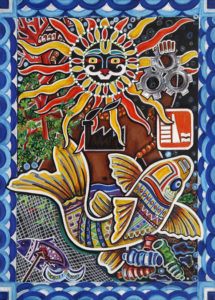
Look closely at the artwork and answer the following questions:
- What colors, shapes, images do you see?
- What questions do you have about this artwork?
- What do you think this artist is trying to say through her artwork?
Read Vedika’s artist statement, then answer the following questions:
- What subject is the artwork about?
- What symbols did Vedika utilize and why?
Art-Making Activity: Create your own artwork about climate change using symbolism to get your point across.
“Not Quite a Snail’s Pace” by Mikala Purugganan (age 16, California)
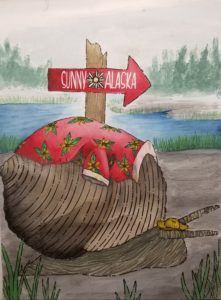
Critical Thinking Questions:
- What do you notice in this artwork?
- What is happening here? Why?
- What is the artist contrasting in this image?
Writing Activity: Create a short story based on this artwork.
“Our Future” by Jane Zhang (age 13, Canada)
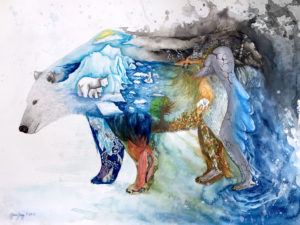
Critical Thinking Questions:
- What various scenes do you see within the polar bear?
- What story do these scenes tell?
- What do you think will happen to the polar bear?
Art-Making Activity: Create an additional scene that shows what humanity could do to save this polar bear.
“Among the Darkness” by Jesse Dong (age 15, California)
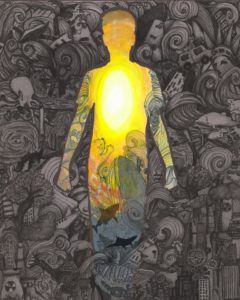
Critical Thinking Questions:
- What colors do you see? Why do you think the artist chose to use these colors?
- Name at least 10 objects or events you see in the dark background. What story do these objects tell us?
- What does the image of the boy in the center represent? Why?
- Do you think this piece is hopeful? Why or why not?
Art-Making Activity: Create a piece of artwork about the climate crisis that evokes a sense of hope. Think about what colors and images you will use and how you will juxtapose them.
“The Book of the Earth” by Denis Avdic (age 14, Bosnia and Herzegovina)
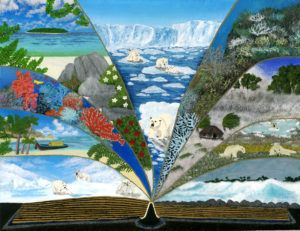
Critical Thinking Questions:
- What scenes do you see in the different images of this book?
- How do the colors change from left to right? What do these changes in color represent?
- What specific effects of climate change do you see pictured in this painting? (If you’re not sure, check out our Resource Studio to learn more.)
Writing Activity: Using the “The Book of Earth” as inspiration, write a short story highlighting the effects of climate change on our oceans.
“The Flight Towards Death” by Erika Sjoblom (age 18, Wisconsin)
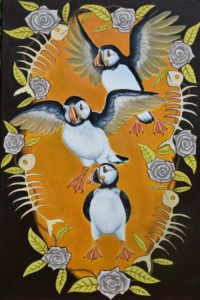
This painting highlights the plight of puffins. Watch the “Puffin Excerpt” from the documentary “From the Bow Seat” (the one that started it all!) by Bow Seat Founder and President Linda Cabot.
- While watching, list 5-10 facts about puffins.
- Complete your own research to learn how puffins are affected by climate change. You can use the following articles to get started:
Art-Making Activity: Using what you learn from this video and your own research, create your own artwork about puffins.
“Past Present Future” By Carol Liang (age 14, Canada)

Critical Thinking Questions:
- Describe the three scenes in this artwork. Which part depicts the past, the present, and the future? How do you know?
- Why is the future less colorful than the past? (hint: read Carol’s artist statement if you’re not sure)
- What could humans do to bring back the color in the future?
Writing Activity: Write a three-part poem that reveals what the diver in each part of the painting sees before him/her.
“Internet Celebrity” by Daven Sohng (age 15, Nevada)

Critical Thinking Questions:
- What statement is the artist making with his artwork? Give 3 specific details from the artwork to support your answer.
- What is the significance of the title “Internet Celebrity”?
- How can the internet be used as a positive tool for advocacy? What can be problematic with internet advocacy?
Activity: Design a social media campaign for a marine plant, animal, ecosystem, or coastal community that will be affected by the climate crisis. Draft posts and images that you believe utilizes social media in a positive way.
Write a Story
“Greed Over Need” by Valentin Nguyen (age 16, California)
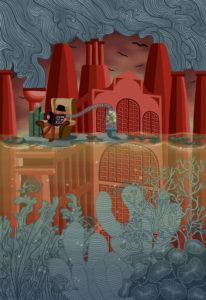
Critical Thinking Questions:
- What are 5 things you notice in this artwork?
- What is the significance of the book title?
- What objects in the painting are green, and why are these objects important?
Art-Making Activity: Write a short story that shows who the person in the painting is and how he/she ended up in this situation.
Visual Thinking Strategy
“A Cry For Help” by Camryn Lipman (age 16, New York)
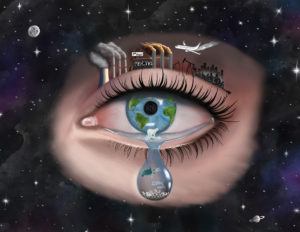
Critical Thinking Questions:
- What is going on in this artwork?
- What do you see that makes you say that?
- What more can you find?
Ask a family member or friend to look at Camryn’s artwork and ask them the same questions (you could do this online!). Discuss the similarities and differences between your answers with your partner.
Creative Activity: Write a magazine article about the causes and effects of the climate crisis using Camryn’s artwork as inspiration. If you don’t know why certain elements are included in her painting, check out our Resource Studio.
Read, Imagine, Create
“Sea Fish Hidden in a Book” by Ke Rao (age 13, China) portrays a student sitting in her bedroom, imagining the sea life she reads about come to life in her mind. Find an article that interests you from our Resource Studio, and create a piece of artwork that portrays the scene you see in your mind as you read. (Not sure what article to pick? May we recommend “In 2030, we ended the climate emergency. Here’s how”)
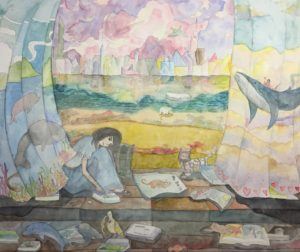
CREATIVE ACTIVITIES AND WRITING PROMPTS INSPIRED BY BOW SEAT PROSE
Read and Create
“KaiStar55’s Exclusive Preview of the Ocean Memorial Museum…” by Daria Syskine (age 18, California)
Illustrate your own contribution to the Ocean Memorial Museum. Write a guide for visitors explaining what they will see in your exhibit and why you chose to include what you did.
Make a Picture Book
“Worthday” by Rose Whelan (age 15, Pennsylvania)
Illustrate a children’s picture book using Rose’s story as inspiration.
Analyze Point of View
Read “SOS: World’s Oceans Ebbing Toward Extinction” by Amanda Hao (age 13, California) and “An Ocean Away” by Sadie Bograd (age 14, Kentucky), then analyze two different points of view on the topic of climate change.
- How do Amanda and Sadie’s points of view differ?
- What are similarities in their points of view?
- Do you agree with their arguments?
- Write a letter in response to either Amanda or Sadie and explain why you agree or disagree with their point of view.
Find & Reflect: Text to Text, Text to Self, Text to World
Read “2040” by Grace Yang (age 14, Massachusetts)
- Find a connection between this text and something else you’ve read.
- Find a connection between this text and your own life experience.
- Find a connection between this text and events in the world.
- Reflect on these connections through writing, then create a piece of artwork that highlights these connections.
Create a Character Map
Read “Symbiosis: Zooxanthellae’s Dance of Love” by Tiffany Vu (age 14, California) and create a Character Map for the characters Coral and Algae.
For more information about coral bleaching, check out this article and others in our online Resource Studio
How to create a Character Map: Draw an image of each character (it can be as simple or detailed as you like) and answer the following questions. Write the answers near the given body part.
- Head: What does this character think about?
- Eyes: What has this character seen?
- Ears: What has this character heard?
- Mouth: What does this character say?
- Heart: What does this character feel?
- Stomach: What is this character worried about?
- Hands: What actions does this character take? (What do they do?)
- Feet: How has this character changed? What will happen to this character in the future?
Write a Letter
Read “To Whom It May Concern…” by Patrick Yang (age 16, Minnesota) and “A Letter to the President” by Jessica Barker (age 16, Tennessee), and write your own letter to an influential person or group of people about climate change.
You could write to:
- Society in the future or the past
- Yourself in the future or the past
- The current or future president of the United States
- The CEO of an oil/gas company
Write a Personal Essay
“Estuaries: Where the Tide Meets the Stream” by Sophia LaPalme (age 16, Alabama)
Sophia chooses the oyster, a species of both cultural and economic importance to her home on the Gulf Coast of Alabama, to highlight the current and future impacts of climate change. Choose a plant or animal species of importance to your region that is vulnerable to the effects of climate change, and write a personal essay explaining how these effects will influence your home and your life.
Write a Parody
Using “A Climate Carol” by Max Murphy (age 18, Massachusetts) as inspiration, write a climate change-inspired parody.
Re-Imagine
After reading “Where the Sky Meets the Sea” by Sylvia Nica (age 17, Ohio), choose a scene from the story and rewrite it as if the story takes place during the coronavirus pandemic.
- What challenges are similar between the pandemic and climate crisis? What challenges are different?
If you are interested in learning more about the connections between COVID-19 and Climate Change, check out the new section in our Resource Studio.
Make an Infographic
Earth’s Underwater Powerhouse: How Global Climate Change Will Affect the Atlantic Thermohaline Circulation and a World That Relies On It by Rachel Percy (age 18, Massachusetts)
Using Rachel’s essay as inspiration, create a series of infographics that:
- Explain thermohaline circulation;
- Illustrate what will happen to the process of thermohaline circulation if CO2 emissions continue to rise; and
- Illustrate what will happen to the process of thermohaline circulation if society decreases the amount of CO2 emissions.
Create a Collage
“Superhero” by Anna Guzman (age 16, California)
- What are the character traits of a superhero? Make a list of words that come to mind.
- Who are your “superheroes”? In the same way that Anna expands her definition of superhero beyond that of comic book characters, you too should think of your real-life heroes. Make a list of these heroes, and try to find photographs of them (or draw your own!).
- Make a collage that incorporates the pictures and words that define what “superhero” means to you.
Visual Art-making
Read “Journey of a Green Sea Turtle” by Dingzheng Wang (age 16, China) and create a piece of artwork that shows how the green sea turtle’s life has changed throughout the three time periods portrayed in the short story.
CREATIVE ACTIVITIES AND WRITING PROMPTS INSPIRED BY BOW SEAT POETRY
“Sunset Sand” by Anish Aradhey (age 14, Virginia)
- Anish explains why he uses repetition in his poem with the line, “I wonder”: “The ocean itself also inspired my poetry—through the structure and repetition, my poem replicates the sound of waves splashing against a beach.” Why is repetition an effective tool to use when writing about the ocean?
- In his poem, Anish speculates as to what the ocean might be thinking as sea level continues to rise. What do you think the ocean would say to humans?
Writing/Art-Making Activity: Starting on line 14, Anish imagines what it will look and feel like when the ocean floods his grandmother’s home. He also created a watercolor painting, “Grandma’s House” portraying this frightening event. Imagine how your own home or the home of a close relative may be affected by climate change. Either write a poem or create a piece of artwork that shows this home in the future.

“If Mother Nature Were in High School” by Phoebe Price (age 16, California)
- Create an identity chart for Mother Nature based on Phoebe’s poem.
- Name at least 5 factors that make Mother Earth who she is
- Why do you think Phoebe chose to give Mother Earth these character traits?
- Do you think that Mother Earth sees herself the same way society sees her? Why or why not?
- What could be done to make Mother Earth healthier? How might her personality change if she were treated better?
- Now imagine a scenario where humanity helps heal Mother Earth. Create a new identity chart for a healthier Mother Earth.
Art-Making Activity: Draw a picture of Mother Earth using this new healed identity.
“Six Degrees” by E Wen Wong (age 15, New Zealand)
- What is the significance of the title “Six Degrees”?
- Identify the changes that take place with each degree of temperature rise.
- Find examples of personification, simile, and metaphor within E Wen’s poem.
Writing Activity: E Wen uses temperature as a device to reveal the changes that will take place to planet Earth as the global temperature continues to rise. Using “Six Degrees” as inspiration, write a poem about an issue that can be quantified by a measurement (such as time, temperature, distance, etc.) and organize your stanzas according to these measurements.
“never forget” by Akhila Bandlora (age 15, Arizona)
- What three time periods are portrayed in “never forget”?
- What are the main events taking place in each of these time periods?
- In part ii, Akhila references several important environmental acts–what are they?
- Choose one of these acts and research what it is and how it changed environmental law. List at least 5 key points about the act.
Art-Making Activity: Using part iii of Akhila’s poem as inspiration, create a piece of artwork or music that represents the spirit of this stanza.
“Alone” by Calum Macdermid (age 17, California)
Watch Calum perform his spoken word poem, then choose a topic relating to the climate crisis, and write and perform your own spoken word poem.
“it’s coming” by SydneyBlu Garcia-Yao (age 13, Pennsylvania)
In the poem, Sydney reveals the plight of Atlantic salmon while using poetic devices such as imagery, similes, metaphors, alliteration, and more. Choose a plant or animal that will be affected by the climate crisis, and write a poem that utilizes several poetic devices to portray the challenges facing your chosen form of marine life.
“Earthly Sins” by Dylan Sanders (age 14, Texas)
- In the first line, Dylan refers to “we”–who is “we” in this poem?
- Would you consider this poem to be hopeful? Why or why not?
- In the final stanza, Dylan shares what he expects of leaders. What do you expect of today’s leaders?
Art-making activity: Design a protest sign inspired by Dylan’s poem. If you are interested, share your protest sign on social media as a part of #schoolstrikeforclimate and #climatestrikeonline started by climate activist Greta Thunberg. Be sure to tag us @fromthebowseat
Comments are closed for this post.
